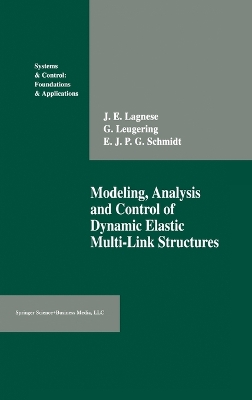Systems & Control: Foundations and Applications
1 total work
Modelling, Analysis and Control of Dynamic Elastic Multi-Link Structures
by J E Lagnese, Guenter Leugering, and E.J.P.G. Schmidt
Published 1 June 1994
A typical subsystem found in almost all aircraft and space vehicles consists of beam, plate and/or shell elements attached to each other in a rigid or flexible manner. Due to limitations on their weights, the elements themselves must be highly flexible, and due to limitations on their initial configuration (i.e., before deployment), those aggregates often have to contain several links so that the substructure may be unfolded or telescoped once it is deployed. The defining philosophy of this monograph is that in order to understand completely the dynamic response of such a complex elastic structure, it is not sufficient to consider only its global motion but also necessary to take into account the flexibility of individual elements and the interaction and transmission of elastic effects such as bending, torsion, and axial deformations at junctions where members are connected to each other.
Therefore, the purposes of this monograph are: to derive distributed parameter models of the transient behavior of some or all of the state and interval variables which describe the dynamic response of multiple-link flexible structures such as trusses, frames, robot arms, solar panels, antennae and deformable mirrors, based on the principles of continuum mechanics and under reasonable constraints on the geometry of the admissible deformations; to provide rigorous mathematical analyses of the resulting models; and to develop control theoretic properties of multiple-link flexible structures based on the control theoretic properties of the models. The modelling and analysis of these complicated and realistic structural configurations should be of interest to a diverse group of applied mathematicians, structural, aeronautical, aerospace, and mechanical engineers and to advanced graduate students working on such problems.
Therefore, the purposes of this monograph are: to derive distributed parameter models of the transient behavior of some or all of the state and interval variables which describe the dynamic response of multiple-link flexible structures such as trusses, frames, robot arms, solar panels, antennae and deformable mirrors, based on the principles of continuum mechanics and under reasonable constraints on the geometry of the admissible deformations; to provide rigorous mathematical analyses of the resulting models; and to develop control theoretic properties of multiple-link flexible structures based on the control theoretic properties of the models. The modelling and analysis of these complicated and realistic structural configurations should be of interest to a diverse group of applied mathematicians, structural, aeronautical, aerospace, and mechanical engineers and to advanced graduate students working on such problems.
